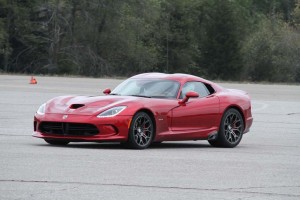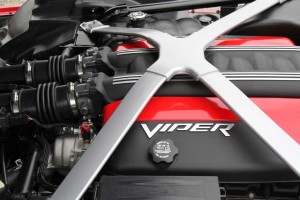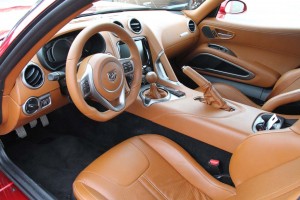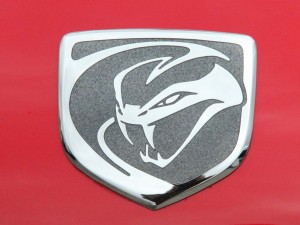The official unveiling of the 2013 SRT Viper at last spring’s New York Auto Show was a boisterous affair. Despite the loud applause, though, there were a few quick to razz the new sports car for looking like little more than a clone of the old coupe. True, the designs are strikingly similar – until you see them sitting side-by-side. The new Viper is no carbon copy, nor is it the rebadged Alfa Romeo many had anticipated in those dark days between the time the old car was pulled from production, in 2010, and word began to leak out that an all-new model was in the works.
Ironically, some of those who loved the old design are also wondering what to make of the 2013 Viper. The concept behind the original 1992 roadster was to come up with a car that was as raw, even brutal, as possible. There were none of the usual amenities. Not even anti-lock brakes or airbags. In a rainstorm it was easier to get drenched than try to install the fold-up vinyl “toupette.” But few cars of the era could come close to matching that first Viper’s pure fun-to-drive factor.
With the addition of the first GTS Coupe and a subsequent list of limited amenities, the Viper did become – dare we say it – a bit more refined over the years. But what to expect from the new one, developed by an all-new management team and subject to new mandates requiring such “niceties” as airbags and electronic stability control? That’s what TheDetroitBureau.com set out to discover as we headed over to the Chrysler Proving Ground in Chelsea, Michigan for our first drive.
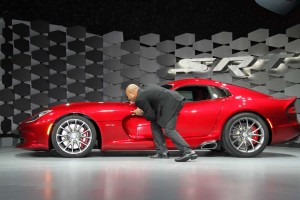
SRT chief Ralph Gilles - also Chrysler's corporate design chief, plants a welcome kiss on the new SRT Viper during its preview at the NY Auto Show.
Our host and companion for the day was Ralph Gilles, Chrysler’s design chief and head of the new SRT brand – whose image planting a big kiss on the Viper during the NY show has seen widespread distribution. Gilles is a serious performance fan and the biggest challenge of the day was prying him out of the new Viper so we could get some seat time.
But before we began we took some time to compare the old coupe and new. As the images here confirm, there’s a fundamental similarity between the designs. But they’re kissing cousins, not identical twins. There’s a certain elegance in the brutishness that carries over from the earlier model, a logic, if you will, that makes sense when Gilles explains that “every vent, every duct is functional” on the 2013 SRT Viper.
And that explains why, on this day, he’s quick to point out that the car has changed quite a bit from what we saw in New York – and will likely be tweaked still more before it reaches showrooms during the first quarter of 2013. Take the front fascia and bumper. Nose on, you no longer can spot the outer treads of the front tire.
The new Viper has been spending a disproportionate share of time in the wind tunnel and it revealed that by widening the nose mere millimeters there was a major aerodynamic gain. Gilles’ team also discovered that an “air curtain,” an air vent in the front wheel well, they could trick the wind into smoothly flowing around the front fenders rather than tangling up and creating lots of drag in the wheel wells.
Truth be told, not every change was functional – unless you’d apply that term to something that makes the driver more comfortable, especially on long drives. In that, case, it would also fit the now upgraded cabin. There’s a whopping 8.4-inch infotainment screen in the new model, and a smaller display for driver information, as well. There’s even a leather-topped instrument panel. And in the new GTS you get a downright lavish cabin that appears to be a real comfort to sit in – once you manage to squeeze inside.
You can upgrade to a high-end sound system with 12 speakers and two subwoofers. And there’s a place to connect your iPhone. The top-line model even features such exquisite details as Alcantara trim. Well, if it’s good enough for Ferrari…
Creature comforts aside, the new Viper team really did focus on what they should have and that means performance and handling. Lift the new clamshell hood and you’re greeted with an extruded aluminum X-brace that reportedly increases chassis stiffness by 50%.
In the end, despite all the new comfort and convenience items, the 2013 SRT Viper weighs in at 3297 pounds – and that’s for the most well-equipped model you’ll be able to order, with its leather and subwoofers. Even there, that’s 30 pounds lighter than before. And the stripped-down Track Pack model should shave off another 57 pounds.
One of the big bragging points for the new snake is that it will boast the best power-to-weight ratio in the industry – better than the Corvette ZR1 or Lamborghini Aventador, in fact.
If you want to do the math, you need to know that the modified 8.4-liter V-10 in the 2013 SRT Viper will turn out an inspiring 640 horsepower and 600 pound-feet of torque – both numbers up by 40 over the last of the old sports cars. And with its big P295/30ZR 18-inch tires up front and P355/30ZR 19-inchers in back, the 2013 SRT Viper has no problem delivering that power to the pavement.
Even a firm squeeze of the throttle, never mind an aggressive stomp, will push you deep into the well-padded Sabelt sport seat. Meanwhile, the new, short-throw 6-speed manual helps you get the most of that raw power.
With the Viper still a work in progress, Gilles and company are cautious about providing quotable numbers but we hear whispering in the low-3 second range for 0 to 60 mph, with top speed likely to nudge 205 to 206 mph.
On an aggressive slalom and cornering course we got to compare Vipers old and new and even the GTS maneuvered the course far more nimbly than the old track edition Viper ACR. Steering is race car responsive and you can readily use both brakes and throttle to induce some desired under or over-steer to wiggle your way around a line of cones.
To scrub off speed, the “base” car now gets the same big Brembo brakes as the old Viper ACR, a significant improvement – especially with the new 4-channel ABS system. The electronic stability control system now mandated by U.S. regulators is relatively benign, even in full-on mode. But you can phase it back or shut it off entirely if you really want to toss the car around.
“We didn’t want to castrate the Viper when you started hanging things out,” Gilles laughs, during one particularly aggressive run around the makeshift handling course.
Driven less aggressively, we found that Viper really has transformed itself into a reasonable proximity of a daily driver as long as you don’t spend too much of your day jouncing along Michigan’s deeply rutted roads.
For those anxious to get in line, Chrysler has just started taking orders, though you’ll have to wait until early next year to take delivery. For those who might still recall the original roadster’s then-steep $50,000 base price, hold your breath. The 2013 SRT Viper will set you back $97,395. And that jumps to $120,395 for the Viper GTS. By comparison, the Corvette ZRI starts at $113,575 and the Aventador at twice the price.
Add to that $1,995 for delivery – and an estimated $2,600 gas guzzler tax. Final EPA certification isn’t in but Chrysler is anticipating mileage of 12 in the city, 19 on the highway. We don’t think that will scare away from many Viper-istas.
If anything, anticipate a long, early line considering production at the newly reopened Viper plant will start at a mere three a day – and reach a max of 12.
We’re sure we’ll continue to hear grumbling from those who might’ve wanted a more radical redesign, from others who wish Fiat had tapped its Alfa Romeo or Ferrari teams for an all-new approach to the Viper platform and powertrain, and from still others who wish Chrysler had gone back to the raw approach of the original.
That said, we think most potential buyers will be snake bit. Yes, there’s a new Corvette coming next year but for anyone but true Chevy loyalists the 2013 SRT Viper will provide will pause when it’s time to decide where to spend your money.


